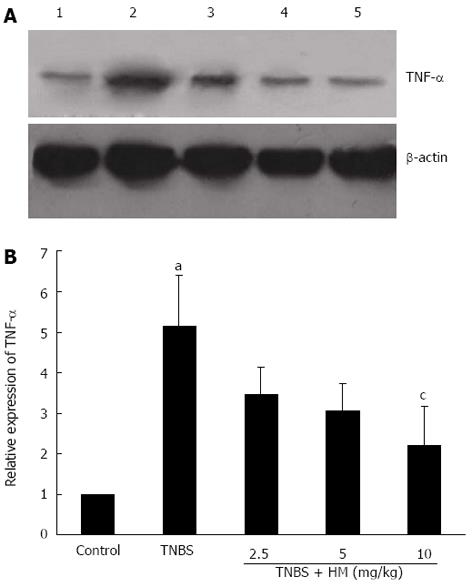Copyright
©2013 Baishideng Publishing Group Co.
World J Gastroenterol. Dec 28, 2013; 19(48): 9318-9327
Published online Dec 28, 2013. doi: 10.3748/wjg.v19.i48.9318
Published online Dec 28, 2013. doi: 10.3748/wjg.v19.i48.9318
Figure 6 Hydroxynaphthoquinone mixture decreases tumor necrosis factor-α expression in colonic tissue of rats with 2,4,6-trinitrobenzene sulfonic acid-induced colitis.
A: Tumor necrosis factor (TNF)-α protein bands; B: Integrated optical density (A) values of protein bands. Colitis was induced by intracolonic administration of TNBS (80 mg/kg, dissolved in 50% ethanol). Rats were treated daily for 7 d with HM (2.5, 5, 10 mg/kg) 24 h after TNBS instillation. Protein extracts were obtained from colons and TNF-α expression level was detected by Western blotting analysis. Lane 1: Controls; lane 2: Rats treated with TNBS alone; lane 3-5: Rats treated with TNBS plus HM (2.5, 5, 10 mg/kg). Data are represented as mean ± SD of 4 animals of each group. aP < 0.05 vs control; cP < 0.05 vs TNBS alone. HM: Hydroxynaphthoquinone mixture; TNBS: 2,4,6-trinitrobenzene sulfonic acid.
-
Citation: Fan HY, Zhang ZL, Liu K, Yang MY, Lv WH, Che X, Xu H, Song WW. Effectiveness of a hydroxynaphthoquinone fraction from
Arnebia euchroma in rats with experimental colitis. World J Gastroenterol 2013; 19(48): 9318-9327 - URL: https://www.wjgnet.com/1007-9327/full/v19/i48/9318.htm
- DOI: https://dx.doi.org/10.3748/wjg.v19.i48.9318









